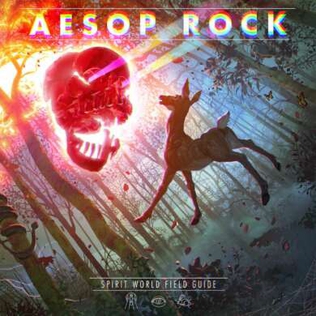Aesop Rock crafts quite the ride on ‘Spirit World Field Guide’

Rhymesayers Entertainment [Fair Use]
As stated in the title “Spirit World Field Guide,” Aesop Rock’s newest album includes twenty one tracks that guide listeners through the “Spirit World.”
December 3, 2020
Aesop Rock’s style has long been defined by a blend of esoteric lyricism and hypnotic hip-hop beats. His latest album, “Spirit World Field Guide,” is no different in this regard.
Where this new record does deviate from formula is in its conceptual nature and worldbuilding. It is this nuance, along with everything else that fans have come to expect from an Aes project, that sets the album apart and makes it well worth multiple listens.
The record is presented to the listener as a handbook detailing the intricacies of the so-called “Spirit World.” In other words, it is a literal “Spirit World Field Guide.” Said world is a realm outside of our own, a place where one might willingly go or find themselves unintentionally.
The concept is set up by the intro track, “Hello From The Spirit World,” in which Aes provides a sort of foreword that gives context to the songs that follow. This track does come across as a little campy, with Aes taking the concept maybe a bit too seriously for us to take him seriously, though it helps in introducing the world of the album.
In an interview with Flood magazine, Aes described the Spirit World as “an attempt to name the mindset of someone who may feel disconnected and/or alone.” This idea is conveyed through recurring themes of alienation and frustration throughout the tracklisting.
The songs’ messages aren’t always downbeat, though. On several tracks, Aes seems to embrace his outsider status, giving the songs an empowering feeling. For example, the track “Coveralls” features lines like “I’m at home on the razor’s edge,” and (a personal favorite of mine) “most of my visitors request that I be tied to a chair / I wear the skin of my detractors, maybe try not to stare,” lyrics that bolster the idiosyncratic style that has made Aesop Rock so successful in the hip hop underground.
As with his last two solo records, the album is self-produced. Aes’ is as dark and trippy as ever, particularly reminiscent of 80’s video game music this time around The mix makes use of samples ranging from the Beastie Boys (“Salt”) to the Wu-Tang Clan (“The Gates”) which adds to the album’s retro feel.
The song “Boot Soup” is a shining example of the thick bass lines and dark, lofi drums that populate the album’s instrumentals. As a counterpoint, the track “Kodokushi” shows off the album’s electronic elements in full effect. The sonic quality of the music alone is enough to draw a listener in even if they aren’t interested in deciphering the cryptic lyrics.
As for said lyrics, well, they’re just as abstract and metaphorical as ever. It can reasonably be concluded that Aes is either extremely well-read or absolutely insane when he writes bars like “Heavy on malaise and away games / The tiptoe tailed by a trail of craters / I am way too Canis Major, et tus?”
This is not to say that every lyric is too abstruse to enjoy, and there are plenty of moments of humor on the record as well. For example, the line, “‘Ummm, that’s really cool your poodle made the paper’ / Let’s keep it at shoes in a elevator” is just the type of clever humor one would expect from a lyricist like Aesop Rock.
Although Aes isn’t exactly known for making “catchy” tunes, several of the choruses on this album are just that. Not exactly in the hum-it-during-class kind of way, but in a head-rocking in your car kind of way. The delivery on some of these choruses can almost be described as stilted or limping, which can sometimes interrupt the flow of the track, but often works in the song’s favor.
“Spirit World Field Guide” is quite the ride and an incredibly solid entry in Aesop Rock’s discography. The album won’t be for everyone, and if you’re looking for easy listening, you might want to sit this one out. But if you’re willing to invest time in analyzing and understanding the album’s lyricism and world building, it can be a very rewarding experience.









